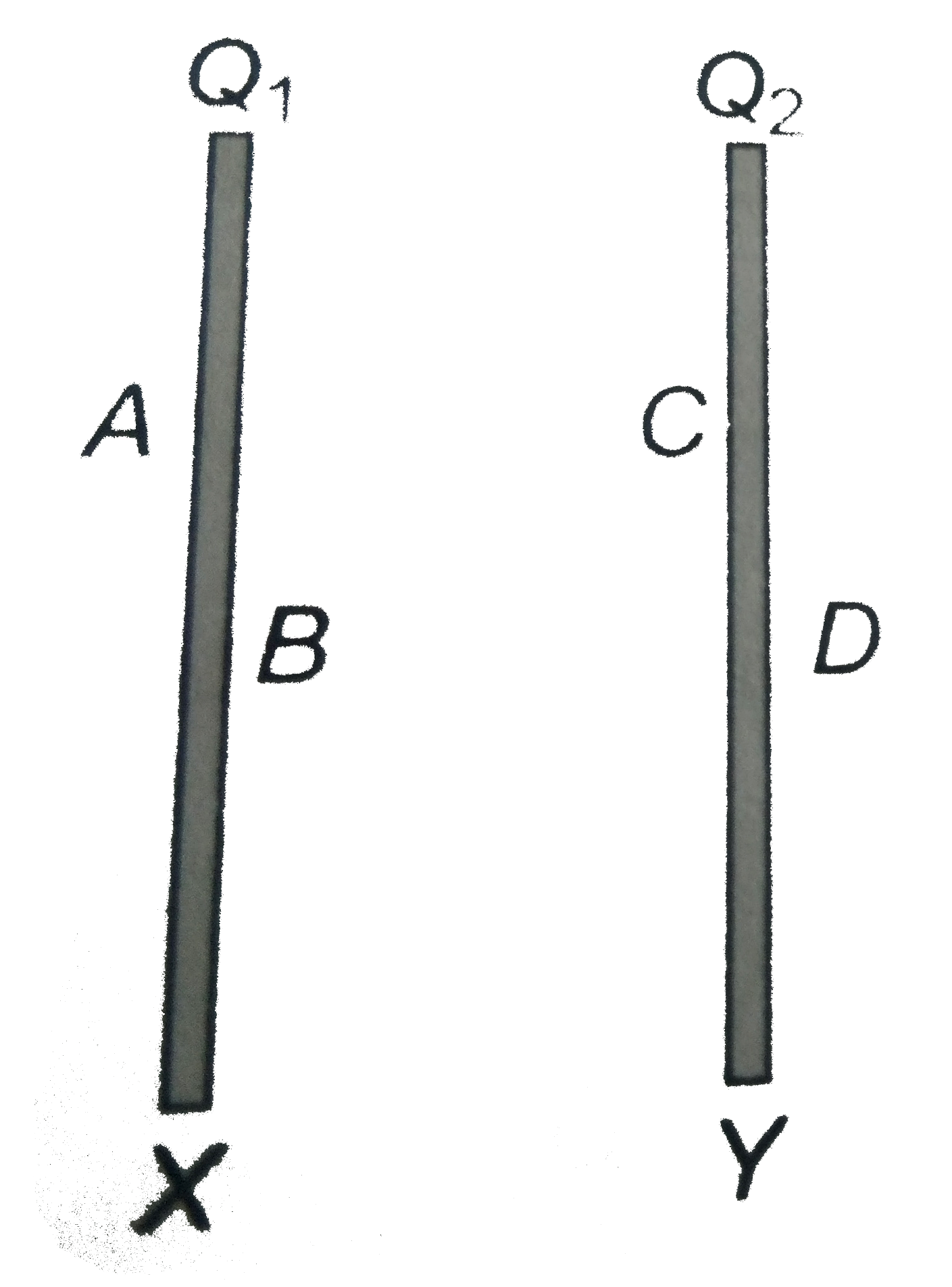A charge of 0.8C is divided into two charges Q1andQ2. These are kept at a separation of 30 cm. The force on Q1 is maximum when Solution in Bengali
Q1=Q2=0.4C
Q1≈0.8C negligible
Q1 negligible, Q2≈0.8C
Q1=0.2C,Q2=0.8C
We have Q1+Q2=0.8C
Therefoe, the force of attraction between the two charges,
F=Q1Q24πε0r2=Q1(0.8−Q1)4πε0×(30×10−2)2
This force will be maximum if dFdQ1=0
∴ddQ1⎡⎣Q1(0.8−Q1)4πε0×(30×10−2)2⎤⎦=0
or, Q1=0.4CandQ2=0.8−0.4=0.4C
The option (A) is correct.
Topper's Solved these Questions
- BOOK - CHHAYA PUBLICATIONCHAPTER - ELECTRIC FIELDEXERCISE - EXAMINATION ARCHIVE ( JEE MAIN )3videos
ELECTRIC FIELD
- BOOK - CHHAYA PUBLICATIONCHAPTER - ELECTRIC FIELDEXERCISE - EXAMINATION ARCHIVE ( AIPMT)1videos
ELECTRIC FIELD
- BOOK - CHHAYA PUBLICATIONCHAPTER - ELECTRIC FIELDEXERCISE - EXAMINATION ARCHIVE (WBCHSE)13videos
ELECTRIC FIELD
- BOOK - CHHAYA PUBLICATIONCHAPTER - ELECTRIC ENERGY AND POWEREXERCISE - CBSE SCANNER7videos
ELECTRIC ENERGY AND POWER
- BOOK - CHHAYA PUBLICATIONCHAPTER - ELECTRIC POTENTIAL EXERCISE - CBSE Scanner13videos
ELECTRIC POTENTIAL
Similar Questions
A long cylindrical shell carries positive surface charge σ in the upper half and negative surface charge −σ in the lower half. The electric field lines around the cylinder will look like figure given in (figures are schematic and not drawn to scale)
02:31View SolutionThe eletric field in a certina region is acting radially outward and is given by E = Ar. A charge contained in 'a' centred at the origin of the field will be givne by
01:40View SolutionFour point charges +q,+q,+q and −q are placed at the four comers of a square, length of each side of which is a.
Find the magnitude of the intensity of the electric field at the centre of the square.02:03View SolutionA light bulb is rated 100 W for 220 V ac supply of 50 Hz. Calculate
the resistance of the bulb ,02:12View SolutionA test charge q is moved without acceleration along the path from A to B from B to C in electric field E as shown in fig.

(i) Calculate the potential difference between A and C.01:17View SolutionAssertion: Two charges q_(1) and q_(2) are placed at separation r . Then magnitude of the force on each charge is F . Reason: Now a third charge q_(3) is placed near q_(1) and q_(2) . Then force on q_(1) and q_(2) remains F .
01:29View SolutionWhen two charges q1andq2 are kept at some distance apart, force acting between these charges is F. If a third change q3 is placed quite close to q3 is placed quite close to q2 what will happen to the force between q1andq2 ?
02:30View SolutionTwo large , parallel conducting plates X and Y , kept close to each other , are given Q1 and Q2(Q1>Q2). The four surfaces of the plates are A,B,C and D , as shown

(i) The charge on A is 12(Q1+Q2)
(ii) The charge on B is 12(Q1−Q2)
(iii) The charge on C is 12(Q2−Q1)
(iv) The charge on D is 12(Q1+Q2)03:23View SolutionA charge q1 exerts some force on a second charge q2 If a third charge q3 is brought near q2, then the force exterted by q1 on q2
03:55View Solutionदो आवेशों q1 तथा q2 के बीच लगने वाला कूलॉम बल, F=q1q2r2 है। एक बल का मान -
03:07View Solutionq1 और q2 इस प्रकार के बिंदु आवेश है कि q1×q2>0 दोनों आवेशों के बीच बल की क्या प्रकृति है?
04:13View SolutionA charge Q is divided into two parts q1 and q2 such that they experience maximum force of repulsion when separated by certain distance. The ratio of Q,q1 and q2 is
View SolutionA certain charge 2Q is divided at first into two parts q1 and q2. Later the charges are placed at a certain distance. If the force of interaction between two charges is maximum then Qq1 = ________.
View Solutionएक लघु द्विध्रुव के अक्ष पर स्थित एक बिंदु आवेश पर विद्युत बल F है। यदि दूरी को दोगुना करने के लिए आवेश को अक्ष के अनुदिश स्थानांतरित किया जाता है, तो विद्युत बल का अभिनय होगा:
06:43View SolutionElectric force between two point charges q_(1) and q_(2) at rest is F. Now is a charge -q_(1) is placed next to q_(1) . What will be the (a) force on q_(2) due to q_(1) (b) total force on q_(2) ?
03:08View Solution

